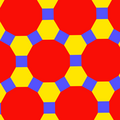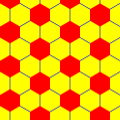Category:Platonic, Archimedean and Catalan solids with direction colors
This set contains renderings of Platonic, Archimedean and Catalan solids that all have the same midsphere, and have the same colors assigned to space directions.
Images 4-4, 6-8 and 12-20 (and their duals) also have a version that touches the sphere with the blue vertices (or faces), so they fit in a truncation sequence. They have "blue" added to their file name.
The solids with icosahedral symmetry also exist in a big version, because their higher sphericity allows it. Their midsphere is 1.2 times bigger. They have "big" added to their file name.
There are also images of each solid where the margin is as small a possible. They have "max" added to their file name.
Each solid also has an orthographic projection from each of the main directions. They have "from red" etc. added to their file name.
These images have been created with Python and POV-Ray. The source code is on GitHub: https://github.com/watchduck/convex_polyhedra
The POV-Ray files for the individual solids are here,
e.g. great_rhombi_12-20_dual.pov
for File:Polyhedron great rhombi 12-20 dual.png.
The coordinates and other properties come from the Visual Polyhedra page by David I. McCooey, e.g. page and coordinates for the disdyakis 30-hedron.
In the Python code the coordinates are used in polyhedron_properties.py.
|
Truncation sequence from cube to octahedron The solid in the middle touches the sphere with its blue vertices rather than its edges, and therefore has "blue" added to its filename. (It is slightly smaller than the cuboctahedron in the main file.) perspective from red from blue from yellow |
Octants with octahedral and icosahedral direction colors The cuboctahedron, a truncation of the cuboctahedron and the solid usually called "truncated cuboctahedron" Icosahedron with tetrahedral, pyritohedral and icosahedral symmetry |
| related image sets |
|---|
|
The polyhedra in these sets are shown from the same angle. Those in the last one also share the same midsphere. Some related polyhedra that are not Platonic, Archimedean or Catalan are in Polyhedra with direction colors (image set). Many images use these colors in the same way. The polyhedra among them are in Polyhedra with direction colors (red, yellow, blue). |
| tetrahedral (cat) | octahedral (cat) | icosahedral (cat) | |||
|---|---|---|---|---|---|
 6 blue points |
 12 blue points |
 30 blue points |
| Platonic (cat) | |||||
|---|---|---|---|---|---|
 pair 4-4 (cat) |
 pair 6-8 (cat) |
 pair 12-20 (cat) | |||
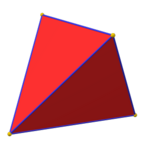 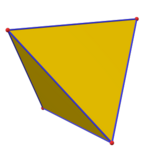 4 (cat a/b) |
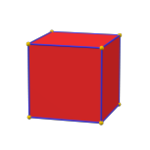 6 (cat) |
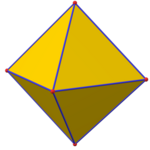 8 (cat) |
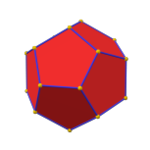 12 (cat) |
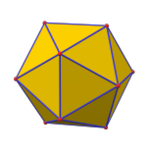 20 (cat) | |
| truncated | |||||
|---|---|---|---|---|---|
  truncated 4 (cat a/b) |
 truncated 6 (cat) |
 truncated 8 (cat) |
 truncated 12 (cat) |
 truncated 20 (cat) | |
  kis 4 (cat a/b) |
 kis 8 (cat) |
 kis 6 (cat) |
 kis 20 (cat) |
 kis 12 (cat) | |
| rectified | |||||
|---|---|---|---|---|---|
 4-4 (cat) |
 6-8 (cat) |
 12-20 (cat) | |||
 rhombic 6 (cat) |
 rhombic 12 (cat) |
 rhombic 30 (cat) | |||
| rhombi | |||||
|---|---|---|---|---|---|
 small rhombi 4-4 (cat) |
 great rhombi 4-4 (cat) |
 small rhombi 6-8 (cat) |
 great rhombi 6-8 (cat) |
 small rhombi 12-20 (cat) |
 great rhombi 12-20 (cat) |
 deltoidal 12 (cat) |
 disdyakis 6 (cat) |
 deltoidal 24 (cat) |
 disdyakis 12 (cat) |
 deltoidal 60 (cat) |
 disdyakis 30 (cat) |
| snub | |||||
|---|---|---|---|---|---|
  snub 4-4 (cat left/right) |
  snub 6-8 (cat left/right) |
  snub 12-20 (cat left/right) | |||
  pentagonal 12 (cat right/left) |
  pentagonal 24 (cat right/left) |
  pentagonal 60 (cat right/left) | |||
| chamfered (cat) | |||||
|---|---|---|---|---|---|
| For clarity's sake the chamfered Platonic solids with equal edge length are shown here. (The yellow faces in the canonical forms are very small.) But the duals below are dual to the canonical forms. | |||||
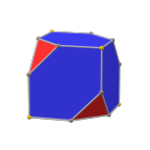 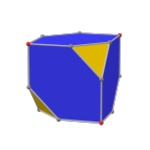 chamfered 4 (cat a/b) |
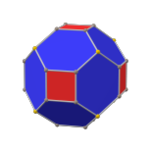 chamfered 6 (cat) |
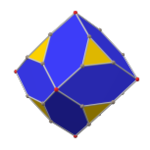 chamfered 8 (cat) |
 chamfered 12 (cat) |
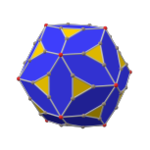 chamfered 20 (cat) | |
  alternate-3-kis 4-4 (cat a/b) |
 4-kis 6-8 (cat) |
 3-kis 6-8 (cat) |
 5-kis 12-20 (cat) |
 3-kis 12-20 (cat) | |
Subcategories
This category has the following 8 subcategories, out of 8 total.
P
- PAC solids with direction colors; vertex numbers (1 P, 34 F)
Pages in category "Platonic, Archimedean and Catalan solids with direction colors"
The following 3 pages are in this category, out of 3 total.





































